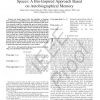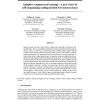2703 search results - page 125 / 541 » Learning operational requirements from goal models |
TSMC
2010
13 years 2 months ago
2010
In Smart Spaces (SSs), the capability of learning from experience is fundamental for autonomous adaptation to environmental changes and for proactive interaction with users. New re...
ICASSP
2010
IEEE
13 years 8 months ago
2010
IEEE
Sparse coding networks, which utilize unsupervised learning to maximize coding efficiency, have successfully reproduced response properties found in primary visual cortex [1]. Ho...
IROS
2009
IEEE
14 years 2 months ago
2009
IEEE
— The goal of this paper is to serve as a reference for researchers in robotics and control that are interested in realistic modeling, theoretical analysis and simulation of wire...
CVPR
2006
IEEE
14 years 10 months ago
2006
IEEE
Multi-camera tracking systems often must maintain consistent identity labels of the targets across views to recover 3D trajectories and fully take advantage of the additional info...
CVPR
2008
IEEE
14 years 10 months ago
2008
IEEE
With the emergence of new applications centered around the sharing of image data, questions concerning the protection of the privacy of people visible in the scene arise. Recently...


